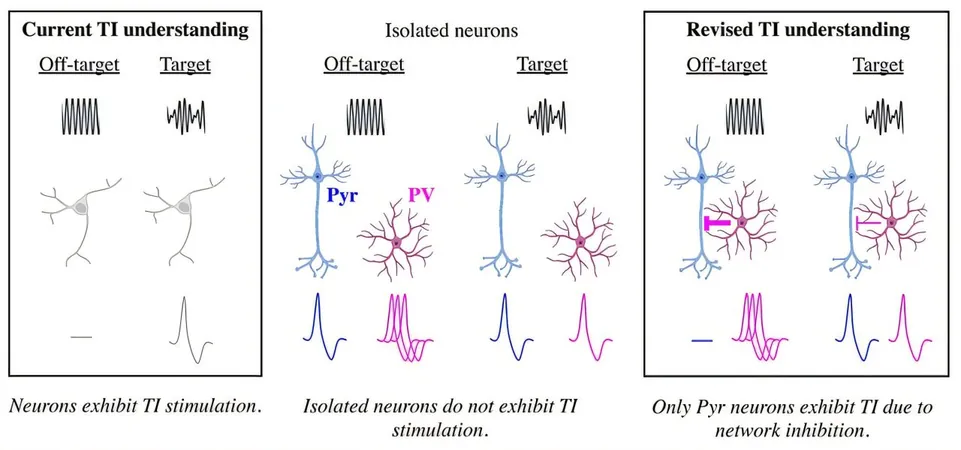
Breakthrough Study Unveils the Secrets of Non-Invasive Deep-Brain Stimulation—Could This Change How We Treat Mental Disorders?
2025-01-21
Author: Arjun
Groundbreaking Study Overview
A groundbreaking study from Carnegie Mellon University is reshaping our understanding of non-invasive neurostimulation techniques that can target deep brain areas without affecting the superficial ones. This study, recently published in Communications Biology, sheds light on a novel method known as temporal interference (TI) stimulation, which is being hailed as a game changer for treating various brain disorders.
Mechanism of TI Stimulation
The goal of non-invasive neurostimulation is to stimulate specific deep brain regions while bypassing shallow areas. TI stimulation does this by cleverly combining multiple electrical frequencies, allowing it to reach deeper areas of the brain without compromising nearby shallow regions. The study's findings indicate that TI stimulation activates parvalbumin (PV) neurons—crucial players in neural networks—in both shallow and deep brain regions.
Differing Effects of TI Stimulation
An intriguing aspect revealed by the study is the differing effects of TI stimulation across these regions. In superficial areas, strong activation of PV neurons inhibits excitatory pyramidal (Pyr) neurons, preventing them from firing. This means that while the deep brain benefits from increased Pyr neuron activity, the shallow areas experience heightened inhibition, effectively safeguarding them from unintended stimulation.
Significant Discoveries and Implications
Sara Caldas Martinez, a Ph.D. student at Carnegie Mellon, made a pivotal discovery by examining how these neurons reacted to TI stimulation. She found that Pyr neurons do not respond isolated from their networks; their activity relies on connections within the overall neural circuits. This significant revelation could challenge prior assumptions about how neurons individually respond to such stimuli, emphasizing the necessity of understanding the broader neural network.
Potential Benefits and Future Applications
The implications of this research are far-reaching. With a clearer understanding of how TI stimulation operates, researchers can enhance treatment options for conditions such as depression, PTSD, OCD, addiction, and other substance abuse disorders. "Recognizing that TI stimulation is grounded in network dynamics rather than single-cell behavior opens new avenues for exploration," Martinez stated.
Non-Invasive Approach and Its Advantages
Unlike traditional invasive techniques, TI stimulation is non-invasive—eliminating the need for electrodes to be implanted directly in the brain. Professor Pulkit Grover, who is part of the study, notes the pressing need for effective treatments without the risks associated with invasive methods. "The potential here is impressive," Grover explained. "If we can enhance specificity and tailor treatments to individual needs, we could revolutionize care."
Limitations and Future Research
However, he also highlighted the limitations of TI stimulation, including the tendency to affect shallow brain areas more than desired. The research team makes it clear that while the approach is promising, it must be rigorously tested to safeguard against side effects.
Interdisciplinary Collaboration
This study exemplifies an interdisciplinary collaboration that included not only Grover but also Alison Barth, another biology professor involved in the Neuroscience Institute. Barth stressed the excitement surrounding the potential applications of this technique. "The capacity to inhibit neural activity in a controlled manner means we can now pursue clinical trials for conditions like epilepsy, chronic pain, and select forms of depression," she enthused.
Conclusion and Future of Neuroscience
The journey of understanding TI stimulation is just beginning, and researchers are gearing up to tackle the challenges and opportunities that lie ahead in the arena of deep-brain stimulation. With the confidence that comes from newfound knowledge, the future of treating brain disorders could look radically different. Are we on the brink of a non-invasive revolution in neuroscience? Only time will tell!



 Brasil (PT)
Brasil (PT)
 Canada (EN)
Canada (EN)
 Chile (ES)
Chile (ES)
 Česko (CS)
Česko (CS)
 대한민국 (KO)
대한민국 (KO)
 España (ES)
España (ES)
 France (FR)
France (FR)
 Hong Kong (EN)
Hong Kong (EN)
 Italia (IT)
Italia (IT)
 日本 (JA)
日本 (JA)
 Magyarország (HU)
Magyarország (HU)
 Norge (NO)
Norge (NO)
 Polska (PL)
Polska (PL)
 Schweiz (DE)
Schweiz (DE)
 Singapore (EN)
Singapore (EN)
 Sverige (SV)
Sverige (SV)
 Suomi (FI)
Suomi (FI)
 Türkiye (TR)
Türkiye (TR)
 الإمارات العربية المتحدة (AR)
الإمارات العربية المتحدة (AR)